Why do many anglers stomp into the water and spook every fish in close distance before they even lay out their first cast? GFF partner Martin Joergensen recommends staying on land.
OK, I'm provoking, and I know it... but the idea of not wading straight into the water might need some exaggeration to knock in to some anglers' thick skulls. Not yours of course, but the other clowns who stomp into the water and spook every fish within close distance before they even lay out their first cast.
The opposite bank
I don't know how many times I have heard this advice on a stream when fishing a dry fly: cast as close as you can to the opposite bank. If you don't catch the grass or the bushes over there once in a while, you're not close enough!
For some reason the fish seem to be holding under the opposite bank in every stream in the world.
Same thing when fishing for salmon. You gear up to be able to cover the whole stream, and unless you are fishing a large river it's certainly possible to cast across to the opposite bank and cover the whole width of many streams.
But why on earth are the fish holding under the bank across from where you got in the water? Well, they aren't... or weren't until you stepped into the water. The fish are of course all over the stream – on your side, in the middle and close to the opposite bank.
So why would you choose to fish for those over there rather than the ones right under your nose? Well, it beats me!
For some reason the fish seem to be holding under the opposite bank in every stream in the world.
OK, sometimes
Sometimes there will of course be fish opposite from you and not right where you are standing. Some stream bends are very shallow on the inside and very deep and undercut on the outside, and in such a case there might be more fish in the deeper water than in the shallow. And if you are standing in the shallows on the inside of the bend, there may be more fish opposite of you.
But that's not always the case.
Fish can easily hold right before your feet, and I dare any angler to say that he or she has never surprised a fish when wading into the water!
No matter if you fish lakes, the salt, streams or large rivers, you will have seen good fish disappear in cloud of mud or sand or with a huge whirl or splash, scared by your shadow or by your splashing into the water.
The fish are there, in the shallows, close to the bank or the beach, and the structures that attract them on the opposite side of the stream, can very likely be found on your side, just a few dozen yards – or even less – up- or downstream from where you are.
Don't wade, you idiot!
That's why I urge you not to wade. Or at least wait and see before you step into the water. I know that it makes little sense to fish from the shore or the bank of some waters. Reed filled lake banks is a good example, and streams with “dead” water between rocks close to the bank and a healthy current further out is another example. In these cases and others, you can of course step over the fishless or unfishable water to get to where the fish are.
But in many other cases you might do yourself a favor by waiting and observing or maybe simply probing the water with a fly before entering.
Do not disturb
Many streams are also quite fragile, and even though we may think our entry and walking on the bottom is quite stealth, we do disturb. Mud will be kicked up, plants will be stepped on, spawning redds may be damaged, and the fish we spook will be stressed. Some streams even have wading bans, and in such cases the decision has been made for you: don't wade.
There's one other good reason to stay on shore, and that's depth! Some waters are simply too deep to wade, and that of course gives you a very good reason to fish them from the dry.
But even though you can wade, do consider staying on land, at least until you have watched the water close by and made sure no fish are active there.
Looking upstream
If you are streamfishing, it's always a good idea to offer the upstream part of the stream some attention. Fish up there are facing away from you and might not see you as easily as you approach.
So look upstream, and don't just look midstream or across, but also close to your own bank. If you see fish moving or rising you can of course cast to the fish from your current position if it's within reach, but you risk casting over it and spooking it.
Consider getting out of the water and approaching the fish from the bank
Mending in
I have been salmon fishing a few times, and I most definitely enjoy laying out a good line across the stream, mending it upstream and seeing and feeling the fly swing across the current and pick up speed.
I know when to concentrate during the swing and have felt that reassuring tug many times, right there where I expected it, right there where the fly was fishing at its best and where I anticipated the fish to be.
But I have also taught myself to fish the cast all the way to the end, and letting the fly swing all the way downstream from my position. And I have even made it a habit to “mend the line in”, meaning casting a small arc in its belly towards my own bank for a last small swing right on the edge between shallow and embarrassingly shallow. And I have caught several nice fish and had quite a few surprise takes right there, right where I'd be wading in less than 10 minutes if I had continued one step one cast downstream.
The comfort lane
Once when fishing for steelhead in Skeena in BC these magnificent fish were definitely traveling very close to our own bank, and I remember the guide mentioning this fact several times.
The Skeena is a large river. Like in really large! The river is wide, deep and rough and if I were a fish, I'd also go for the “comfort lane” as I call it, which is right where the slow speed of the water close to the bank and the depth of the water meets in a blend, which feels safe to travel for a fish and maybe isn't quite as hard to work against as it is just a few yards further out.
And we experienced this lane to be very close to the bank in many of the places that we fished, just a few yards or a couple of meters out from dry land. We caught fish there and had takes there.
Saltwater
It's not only in the streams that fish move close to the shore. Having fished for bonefish a couple of times, I have noticed that they also travel and feed close to the bank. When approaching the water we would be scouting for fish further out, but once we were in the water, we would often see fish tailing very close to the beach in places very much like the one where we just entered. When wading the lagoons in Yucatan we would many times come from the open water and fish in towards the beach in places where we might as well have stalked the fish from the dry land itself, which would even have been easier and more comfortable because we could be standing on terra firma rather than wading the muddy and silty bottom of the lagoons.
Crossing over the small mangrove banks between the arms of the lagoons, often put me in a great position for spotting fish: slightly elevated and often hidden by the vegetation. Casting could be tricky, but on the other hand the fish would sometimes be very close.
Walking casting
I have good friend who fishes the Danish inshore for sea run brown trout like I do, and when he moves from one location to another, he does so with a suitable length of fly line out the tip of his rod. He then walks along very close to the waterline, and roll casts once for every few steps. He doesn't strip in or fish the fly actively, but lets it splash and move as it does as he walks along.
What he obtains from this is to get fish to move, attracted by the fly. As soon as he sees anything he stops, lifts the line and makes a “real cast” and strips back the fly.
This can be a surprisingly efficient strategy.
I personally don't cast while walking, but my eyes are glued to the water close to the shore, and it's happened many times that I've seen fish and been able to cast to them at very short range in the very shallow.
Kneeling
Whether you fish a stream, a lake or the ocean it's always a good idea to look for cruising and feeding fish close to the bank. Stay on the bank at a safe distance from the water and use your eyes. You'd be surprised how close the fish can be.
In some cases you may be able to cast from the distance, and during mullet fishing on the coast here, I have hooked several mullet by literally laying the line out on the beach while only the leader or even just a part of the leader and the fly landed in the water. It was not easy to control because of weed, grass and rocks in the water's edge, but approaching the water was impossible. It would simply have spooked the fish.
Some fish might be just a bit further out, but close enough to spook. Crouching and kneeling is a good way of hiding yourself, and rocks, bushes and small hills might be worth using as hiding places.
And remember to observe before you cast. You may see a fish further out, but overlook those that hide even closer.
Then wade
Once you have checked out the water close by and maybe fished it, you can of course wade out and look for fish further out. Wading is not forbidden, but it's just a good idea not to plunge into the water.
- Log in to post comments


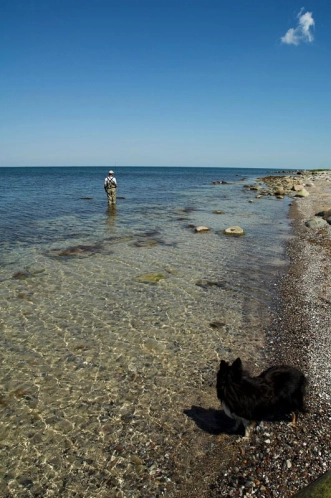
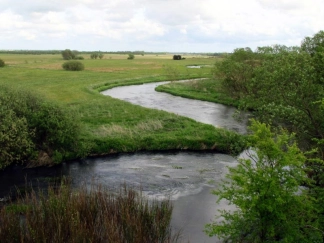

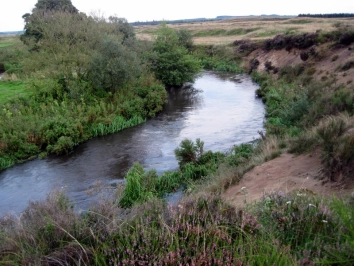


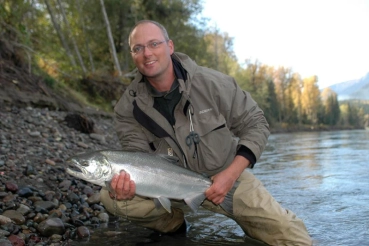

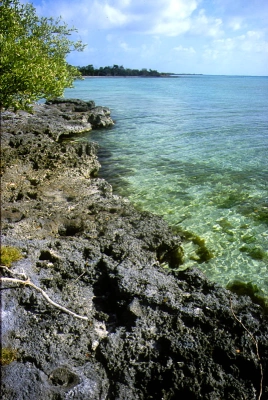
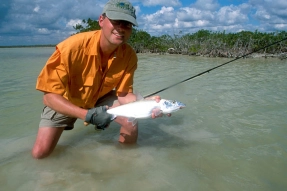

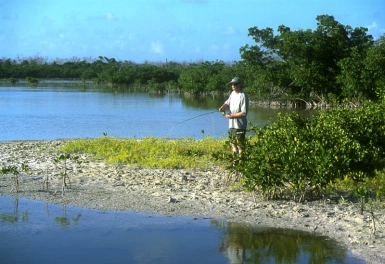
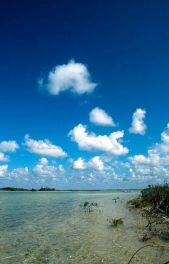





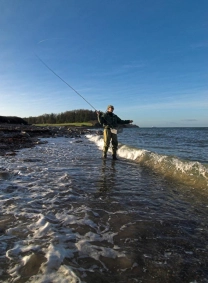

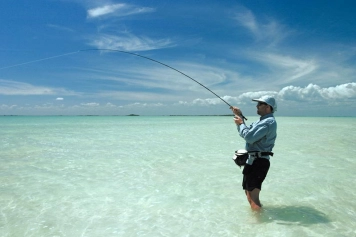

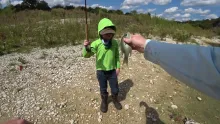
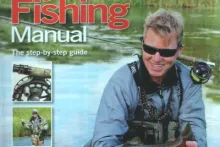

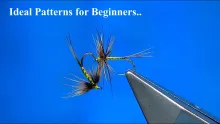



Bravo!!! I guide on
Bravo!!! I guide on NY's Salmon River and the first caution I give after some safety issues is to stay out of the water until we survey river conditions. The higher the water the closer to shore the fish. The general approach of most fishermen is to start knee deep and cast too far. The majority of our fish caught while are caught on short cast with good line control, usually 2 rod lengths of fly line out or less. Now I have an excellent article to reference for my guests!!!
Thanks!
Good points. An 'A'
Good points. An 'A' for common sense.
Fish From Banks!
Fishing from banks works best on the small, wooded, tree covered brooks in Northeast. Less disturbing to fish and far easier to get into tight places. Great place for a Tenkara Rod also.